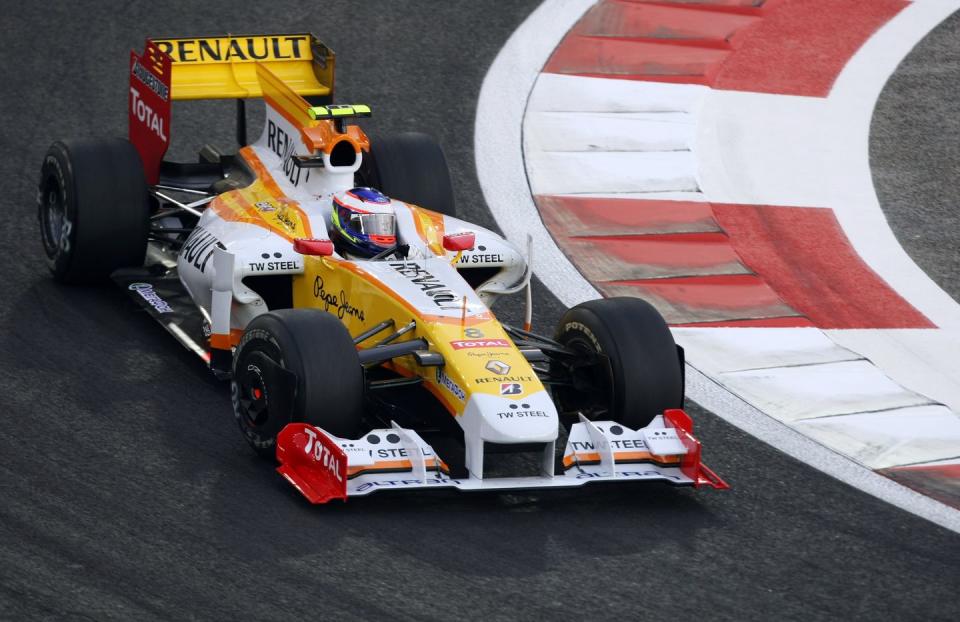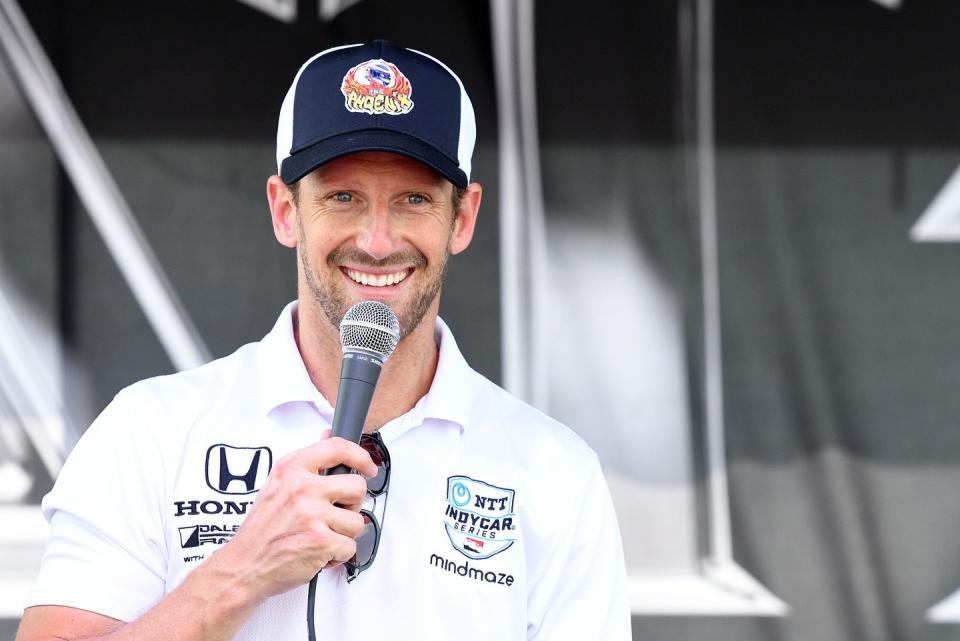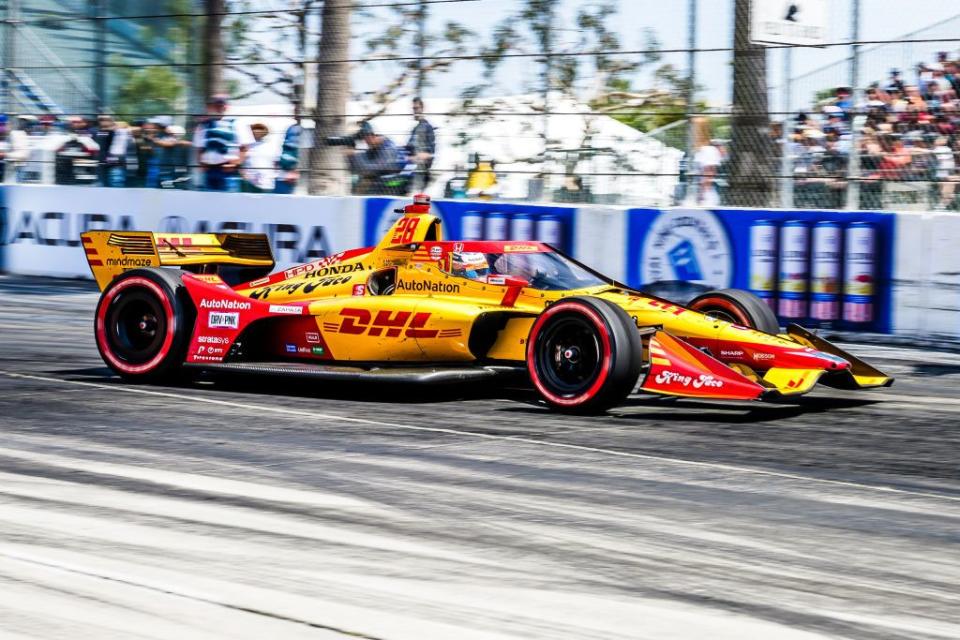Romain Grosjean Is Here for a Reason
- Oops!Something went wrong.Please try again later.
Romain Grosjean is hard to miss. There are a handful of former Formula 1 drivers in IndyCar, and many more who have come before him, but none are quite like the former Renault, Lotus, and Haas driver.
Now well into his second IndyCar season, Grosjean has developed dueling reputations in America. He's a YouTuber, still analyzing F1 in between posts about his career in America. He's a risk-taker, but you have to be if you want to pass a half-dozen cars in an open-wheeler at Laguna Seca just two days after crashing a pace car in the pit lane at the same track. He's an ice racer in his free time, building on a hobby he's had since he drove a Peugeot 205 GTI on frozen lakes outside Geneva. He's also "The Phoenix," the man who survived one of the most horrifying crashes in F1 history. All of it makes him a standout in a series full of standouts, a 36-year-old second-year racer building his way toward championship contention on an entirely new continent.
His IndyCar career is unorthodox, but Grosjean's F1 career was not straightforward, either. It started with a fill-in role in 2009, when Renault hired Grosjean out of GP2 (now Formula 2) to replace Nelson Piquet Jr. midseason. He was out of open-wheel racing entirely until landing at the DAMS Auto GP program midseason in 2010. He went on to win that title in a short season, then the GP2 title the year after that to earn a role at the Lotus F1 team. In those years in between, he saw that racing was more than just F1.
"It was a pretty good experience. I realized I loved F1 a lot and I wanted to make it back, but there was a lot of racing beside it. I was almost ready to have a GT career, but I was lucky enough to meet Jean-Paul Driot and get back into Auto GP, then GP2. I decided it was definitely what I wanted to do, more than GT. I was lucky enough to win the races and make my way back to F1."

That led to a nine-year stint in F1, first with Lotus and then with Haas. The latter was a particular challenge, as Haas was the first wholly new team to join the F1 grid in years and is the only current F1 team founded from the ground up after 1997. It was a challenge he embraced, though.
"The good thing when I went to Haas is that a lot of the people from Lotus came with me, so it was nice to have familiar faces. Obviously it was building a team from scratch, and it took quite some time, but it was a nice project with a good idea behind it. Lotus was a great time, but after four or five years at Lotus, I wanted something different."
Haas became a magnet for the early seasons of Drive to Survive, the Netflix show that has been such a hit in the U.S. in particular. That in turn made early stars of Grosjean and team principal Guenther Steiner, the most notable people on the team. While Grosjean appreciates what the show has done for the sport, he sees its flaws, too.
"I never watched Season 1, so I don't know what's what. I watched seasons 2, 3, and 4. I think Netflix has been great for Formula 1. The only thing I don't like is that they sensationalized things. They decide which angle they're going to look at for each team, and it's not always the truth. I read about [Max Verstappen's refusal to participate]. I kind of understand his position, but it's a bit of a shame, I think we shouldn't be given a choice. I think it's been awesome for F1, it's been huge. It's opened a lot of new markets and new fans. Yes, they choose the angle, they choose who's the bad boy and the good guy and so on, but it's a lot of views, and the popularity gained everyone gets from it is huge, so I think we should play our role in the game."

Grosjean was a particular focus in one Season 3 episode of the show, the one covering his horrifying crash at Bahrain. Unlike the rest, he's gone out of his way to avoid that one. Burns from that late-season crash meant that it was his last time racing an F1 car before the end of his time with Haas, which had already moved on to an all-new lineup for the 2021 season. His return to racing instead came in his first IndyCar race a few months later, the first of a one-year, no-oval deal designed to see if the series was where he wanted to be long term.
"I felt it was a category where I could have fun and win races, where the car was a very high-performance car of a very competitive level. I was excited to go to new tracks through the U.S. But I didn't know if I was going to like it or not, so it was a one-year contract to come and see. Obviously I loved it, so now I'm full time here and I'm very happy with that."

The particulars of that part-time schedule meant that Grosjean stayed in Europe for the majority of last year and traveled to the U.S. race by race. With a full-time schedule at Andretti Autosport this season, he's moved his family to Florida. He's happy with that, too.
"Last year, I traveled back and forth because I wasn't doing the ovals, [so that commute] was possible. This year, doing the full schedule, it was just too much. I think I crossed the Atlantic 11 times last year, going in and out of the country, so between the jet lag and being away from my family a very long time, it was tough. So when it was clear I was going to go to IndyCar in a top team for a full season, we decided that everyone was going to come with me to the States, and it was about choosing where we wanted to live. Florida was a pretty obvious choice, for the quality of life and happiness of the whole family. I love it. Everyone is super excited, everyone is happy. My kids are coming to Indianapolis to watch the race, and it's a great family experience."
Related video from our friends at Cosmopolitan
Those first races with Andretti Autosport have been an up-and-down experience. Honda, Andretti's engine manufacturer, was winless through the season's first four races. Grosjean came close to taking the manufacturer's first win of the year, and his first ever in an Indy car, at Long Beach, but he came up just short.
"I was on red tires and everyone was on black. We decided to go for a different strategy that was working well, so I know I had a good advantage of grip on those first few laps so I tried to use it as I could. But sadly, early in the race I had to use push to pass to get through the field, and I kind of ran out of push to pass for the end. And Penske (the team of winning driver Josef Newgarden) did a good job with their setup, and they were very fast on the straights, and if we couldn't follow on the straights, that hurts your overtaking chances. And there's marble all over the track so you couldn't really use a different line, so you could only use the racing line."

The next two races were other stories entirely. Last Saturday at the Indianapolis GP, he was one of four drivers running in the top five stuck out by a late decision not to switch to rain tires during the race's final caution. It left him out of what was at least a surefire top-10 finish. Weeks earlier at Barber Motorsports Park, he became the object of competitor Graham Rahal's lasting anger after an on-track crash late in the race for position. Rahal then spent the next two weeks waging war in print over how Grosjean handled the battle. Is he worried about Rahal's concerns about his driving style?
"No, not really. I think he's just frustrated that I passed him on the last lap."
But it's that exact driving style that makes Grosjean such a strong fit for IndyCar. In comparison to racing in F1, he says, "You have to muscle through IndyCar." The more straightforward and more equal cars are harder to drive, but they create closer racing. That generally means you need to strike when you have the chance, something Grosjean has already learned.
"The car is very basic in technology [compared to] F1, but it's very strong and everyone's got the same [chassis], so it's really good racing. The car's got no power steering, so it's very heavy. The aerodynamics are very simplistic, but it's good racing and the mechanical grip is very good. So low speed is very nice, high speed is very tricky, but it's very much a driver's thing."

Grosjean decided to add ovals to his schedule late last season, starting with an electric race at Gateway while he was still with Dale Coyne Racing. He's since completed a race at Texas Motor Speedway with Andretti. He describes oval racing as "very fun, but very physical and tough." Next comes the biggest oval race of all, his first Indianapolis 500.
"I'm as ready as you can be as a rookie, I guess. A lot to learn, a lot to analyze, a lot to understand. But excited for it, for sure. It's the greatest race in the world."
Practice for the 500 started on Tuesday, but Grosjean had already experienced a few laps at Indianapolis in pre-program testing last month. If he did not have a grasp of racing at Indianapolis before, he certainly does now.
"From Europe, it's hard to understand what ovals are. They look boring, but when you drive it it's definitely not boring."
You Might Also Like

